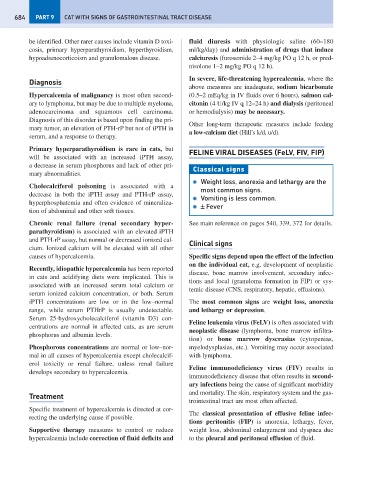Page 692 - Problem-Based Feline Medicine
P. 692
684 PART 9 CAT WITH SIGNS OF GASTROINTESTINAL TRACT DISEASE
be identified. Other rarer causes include vitamin D toxi- fluid diuresis with physiologic saline (60–180
cosis, primary hyperparathyroidism, hyperthyroidism, ml/kg/day) and administration of drugs that induce
hypoadrenocorticoism and granulomalous disease. calciuresis (furosemide 2–4 mg/kg PO q 12 h, or pred-
nisolone 1–2 mg/kg PO q 12 h).
In severe, life-threatening hypercalcemia, where the
Diagnosis
above measures are inadequate, sodium bicarbonate
Hypercalcemia of malignancy is most often second- (0.5–2 mEq/kg in IV fluids over 6 hours), salmon cal-
ary to lymphoma, but may be due to multiple myeloma, citonin (4 U/kg IV q 12–24 h) and dialysis (peritoneal
adenocarcinoma and squamous cell carcinoma. or hemodialysis) may be necessary.
Diagnosis of this disorder is based upon finding the pri-
Other long-term therapeutic measures include feeding
mary tumor, an elevation of PTH-rP but not of iPTH in
a low-calcium diet (Hill’s k/d, u/d).
serum, and a response to therapy.
Primary hyperparathyroidism is rare in cats, but
FELINE VIRAL DISEASES (FeLV, FIV, FIP)
will be associated with an increased iPTH assay,
a decrease in serum phosphorus and lack of other pri-
Classical signs
mary abnormalities.
● Weight loss, anorexia and lethargy are the
Cholecalciferol poisoning is associated with a
most common signs.
decrease in both the iPTH assay and PTH-rP assay,
● Vomiting is less common.
hyperphosphatemia and often evidence of mineraliza-
● ± Fever
tion of abdominal and other soft tissues.
Chronic renal failure (renal secondary hyper- See main reference on pages 540, 339, 372 for details.
parathyroidism) is associated with an elevated iPTH
and PTH-rP assay, but normal or decreased ionized cal-
Clinical signs
cium. Ionized calcium will be elevated with all other
causes of hypercalcemia. Specific signs depend upon the effect of the infection
on the individual cat, e.g. development of neoplastic
Recently, idiopathic hypercalcemia has been reported
disease, bone marrow involvement, secondary infec-
in cats and acidifying diets were implicated. This is
tions and local (granuloma formation in FIP) or sys-
associated with an increased serum total calcium or
temic disease (CNS, respiratory, hepatic, effusions).
serum ionized calcium concentration, or both. Serum
iPTH concentrations are low or in the low–normal The most common signs are weight loss, anorexia
range, while serum PTHrP is usually undetectable. and lethargy or depression.
Serum 25-hydroxycholecalciferol (vitamin D3) con-
Feline leukemia virus (FeLV) is often associated with
centrations are normal in affected cats, as are serum
neoplastic disease (lymphoma, bone marrow infiltra-
phosphorus and albumin levels.
tion) or bone marrow dyscrasias (cytopenias,
Phosphorous concentrations are normal or low–nor- myelodysplasias, etc.). Vomiting may occur associated
mal in all causes of hypercalcemia except cholecalcif- with lymphoma.
erol toxicity or renal failure, unless renal failure
Feline immunodeficiency virus (FIV) results in
develops secondary to hypercalcemia.
immunodeficiency disease that often results in second-
ary infections being the cause of significant morbidity
and mortality. The skin, respiratory system and the gas-
Treatment
trointestinal tract are most often affected.
Specific treatment of hypercalcemia is directed at cor-
The classical presentation of effusive feline infec-
recting the underlying cause if possible.
tions peritonitis (FIP) is anorexia, lethargy, fever,
Supportive therapy measures to control or reduce weight loss, abdominal enlargement and dyspnea due
hypercalcemia include correction of fluid deficits and to the pleural and peritoneal effusion of fluid.

